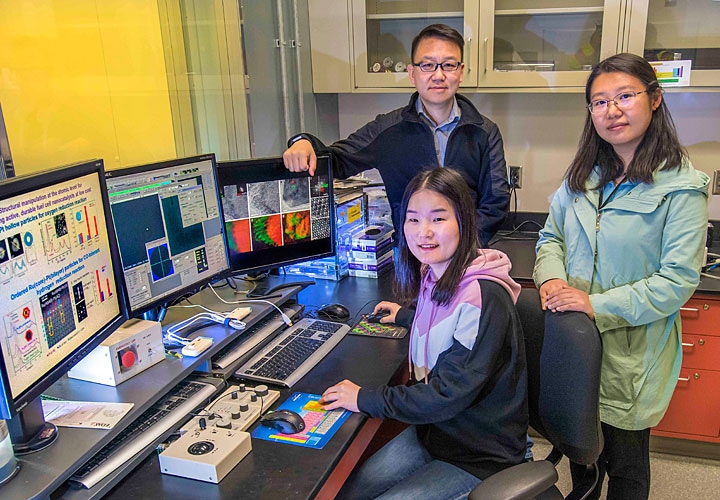May 23 2019
Materials such as fluorides, sulfides, and metal oxides have high energy-storage density and, as a result, they are considered as potential electrode materials, especially for lithium-ion batteries in many different technologies, including electric vehicles.
 Sooyeon Hwang (sitting), Dong Su (left, standing, and Shuang Li at Brookhaven Lab's Center for Functional Nanomaterials, where they used electron microscopes to see how the crystal structure and chemical nature of a battery electrode made of an iron-oxide material called magnetite evolved as lithium was inserted and extracted over 100 charge and discharge cycles. (Image credit: Brookhaven National Laboratory)
Sooyeon Hwang (sitting), Dong Su (left, standing, and Shuang Li at Brookhaven Lab's Center for Functional Nanomaterials, where they used electron microscopes to see how the crystal structure and chemical nature of a battery electrode made of an iron-oxide material called magnetite evolved as lithium was inserted and extracted over 100 charge and discharge cycles. (Image credit: Brookhaven National Laboratory)
Conversely, the capacity of these materials fades very quickly. To address this problem, researchers exploring an electrode fabricated from a non-toxic and low-cost iron-oxide material known as magnetite have suggested a scenario that explains the reason for this capacity loss. The study has been illustrated in the May 20th, 2019 online issue of Nature Communications.
Magnetite, among other conversion-type electrode materials (i.e., materials that get converted into entirely new products when they react with lithium), can store more energy than today’s electrode materials because they can accommodate more lithium ions. However, the capacity of these materials degrades very quickly and is dependent on the current density. For example, our electrochemical testing of magnetite revealed that its capacity drops very quickly within the first 10 high-rate charge and discharge cycles.
Dong Su, Study Lead and Group Leader, Electron Microscopy, Center for Functional Nanomaterials, Brookhaven National Laboratory
The Center for Functional Nanomaterials (CFN) is a U.S. Department of Energy (DOE) Office of Science User Facility at Brookhaven National Laboratory.
To determine the reason behind this substandard cycling stability, the researchers characterized how the chemical nature and crystal structure of magnetite originated as the battery concluded 100 cycles. For these characterization analyses, the researchers integrated synchrotron X-ray absorption spectroscopy (XAS) at the Advanced Photon Source (APS) and transmission electron microscopy (TEM) at the CFN. APS is a DOE Office of Science User Facility at Argonne National Lab. In TEM, an electron beam is passed via a sample to create a diffraction pattern or an image typical of the structure of the material, while XAS utilizes an X-ray beam instead to examine the material’s chemistry.
With the help of both these methods, the researchers found that magnetite fully decomposes into lithium oxide and metallic iron nanoparticles at the time of the initial discharge. However, in the subsequent charge, this conversion reaction is not fully reversible—that is, residues of lithium oxide and metallic iron continue to be present. In addition, the magnetite’s original “spinel” structure develops into a “rock-salt” structure (the location of the iron atoms is not completely equal in the two structures) at the charged state. With successive charge and discharge cycles, an interaction occurs between the lithium and the rock-salt iron oxide, following which a composite of metallic iron nanoparticles and lithium oxide is formed. Since the conversion reaction is not completely reversible, the remaining products tend to build up. In addition, the researchers discovered that the electrolyte—the chemical medium that allows lithium ions to travel between the two electrodes—decomposes in subsequent cycles.
Our real-time TEM studies in ultrahigh vacuum enabled us to see how the structure of rock-salt iron oxide changes as lithium is introduced after the initial cycles. This study uniquely represents the in situ lithiation of a precycled sample. Previous in situ studies only looked at the initial charge and discharge cycles. However, we need to know what happens over many cycles to design longer-lasting batteries because the structure at the charged electrode is different from that of the pristine state.
Dong Su, Study Lead and Group Leader, Electron Microscopy, Center for Functional Nanomaterials, Brookhaven National Laboratory
Based on their results, the researchers provided an explanation for the capacity loss.
Because lithium oxide has a low electronic conductivity, its accumulation creates a barrier to the electrons that are shuttling back and forth between the battery’s positive and negative electrode. We call this barrier an internal passivation layer. Similarly, electrolytic decomposition hinders ionic conduction by forming a surface passivation layer. This buildup of obstacles blocks electrons and lithium ions from reaching active electrode materials, where the electrochemical reactions occur.
Sooyeon Hwang, Study Co-Lead Author and Staff Scientist, Electron Microscopy, Center for Functional Nanomaterials, Brookhaven National Laboratory
The researchers observed that some of this capacity can be recovered by operating the battery at a low current as this would slow the charge rate and offer a sufficient amount of time for electron transport, but other solutions are required to eventually resolve this issue. According to the researchers, capacity fading could be enhanced by adding other elements to the electrode material and substituting the electrolyte.
The knowledge we gained can generally be applied to other conversion compounds, which also face the same problem with internal and external passivation layers. We hope this study can help guide future fundamental research on these promising conversion-type electrode materials.
Zhongwei Chen, Study Co-Corresponding Author and Professor, University of Waterloo, Canada
The team included researchers from the CFN and Sustainable Energy Technologies Department at Brookhaven Lab, the University of Pennsylvania, APS at Argonne National Lab, and the University of Waterloo in Canada.
The study was supported by the DOE Office of Science, Natural Sciences and Engineering Research Council of Canada, University of Waterloo, and Waterloo Institute for Nanotechnology.
Finding the Cause of Capacity Loss in a Metal-Oxide Battery Material
A video showing the changes in morphology of precycled iron oxide during lithium insertion inside an electron microscope. (Video credit: Brookhaven National Laboratory)